
A look from Granville Street Bridge down on Granville Island.
The "Island" includes a hotel, several theaters, numerous galleries, a huge public market, and many smaller shops. A former industry building houses the "Emily Carr Institute of Art and Design", one of Canada's leading schools of art. You find several artists studios here together with many craft shops. There is a "Kids only Market" with toys, clothes, and video games. There are two playgrounds in the area and a Water Park, so it is no problem bringing kids along. They will love the buskers and street performers - we do. Besides that Granville Island has a number of restaurants.
 "Granville Public Market" is one of the most important markets for fresh food and vegetables in North America, and a Mekka for gourmets. From the fertile Okanagan Valley east of the Cascade Mountains, (4-5 hours drive from Vancouver) you can buy strawberries, apricots, peaches, pears and apples. In the market you find American blueberries in jumbo size, Italian pasta in all shapes and colours, French bread, Canadian baggles,Danish cheese, German sausages, local ostrich medaillons, duck, fish, seafood: wild sockeye salmon, crabs, prawns, clams and mussels. Imported delis from every corner of the world, spices from Asia, domestic and foreign wines, lots of cheese, desserts etc. Inside the market there are several small places to have lunch.
"Granville Public Market" is one of the most important markets for fresh food and vegetables in North America, and a Mekka for gourmets. From the fertile Okanagan Valley east of the Cascade Mountains, (4-5 hours drive from Vancouver) you can buy strawberries, apricots, peaches, pears and apples. In the market you find American blueberries in jumbo size, Italian pasta in all shapes and colours, French bread, Canadian baggles,Danish cheese, German sausages, local ostrich medaillons, duck, fish, seafood: wild sockeye salmon, crabs, prawns, clams and mussels. Imported delis from every corner of the world, spices from Asia, domestic and foreign wines, lots of cheese, desserts etc. Inside the market there are several small places to have lunch.
 We love just strolling around Granville Island enjoying the harbour and the marina, watch people living on house boats. A couple of times we took the small electric powered boats across False Creek.
We love just strolling around Granville Island enjoying the harbour and the marina, watch people living on house boats. A couple of times we took the small electric powered boats across False Creek.
During the season lots of things take place on Granville Island, like New Play Festival (early May), Vancouver International Children's Festival (late May), International Jazz Festival (late June), Vancouver Folk Music Festival (mid July), Vancouver International Comedy Festival (July/August), Vancouver International Wooden Boat Festival (late August), Vancouver International Fringe Festival (early September), and Vancouver International Writers & Readers Festival (late October).
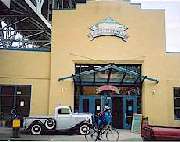 When The Granville Island Brewing Company opened in 1984, it was the first micro-brewery in Canada. There were some problems in the beginning, since federal law required that there should be a public road between the brewery and the store, but the problem was solved. Since then several micro breweries have come to Vancouver, fx Steamworks in Gastown and Yaletown Brewing. In 1995 the brewing operations moved to Kelowna, while the corporate headquarters remained on Granville Island. The following year the company spent more than 1 million dollars "to preserve the breweryís industrial heritage on Granville Island". The main floor includes the brewery, room for tasting the beers, that are being produced on the site, and a retail area.
When The Granville Island Brewing Company opened in 1984, it was the first micro-brewery in Canada. There were some problems in the beginning, since federal law required that there should be a public road between the brewery and the store, but the problem was solved. Since then several micro breweries have come to Vancouver, fx Steamworks in Gastown and Yaletown Brewing. In 1995 the brewing operations moved to Kelowna, while the corporate headquarters remained on Granville Island. The following year the company spent more than 1 million dollars "to preserve the breweryís industrial heritage on Granville Island". The main floor includes the brewery, room for tasting the beers, that are being produced on the site, and a retail area.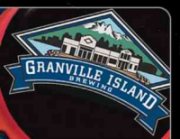 For $6 CDN Granville Island Brewing Company offers a tour which includes sampling 5 beers and a glass to keep. Kids pay $1 for a soda pop, but get no glass to keep. This was the trip that Birgit had to try. She is fond of beer. When we are on holiday fx to countries in the southern part of Europe we usually take at least one beer a day. But in Vancouver it is almost impossible to get a beer. You have to go to special liquor shops to buy them. There are almost no places in the street, where beer is served. And if you find such a place you have to take the beer inside. Considering the fact that many Canadians like beer and that they make really good beer in Canada, it feels a bit ackward - at least to us foreigners. Some of my collegues are member of a club named "Danish Beer Enthusiasts", trying to improve Danish beer quality and maintain old beer traditions.
For $6 CDN Granville Island Brewing Company offers a tour which includes sampling 5 beers and a glass to keep. Kids pay $1 for a soda pop, but get no glass to keep. This was the trip that Birgit had to try. She is fond of beer. When we are on holiday fx to countries in the southern part of Europe we usually take at least one beer a day. But in Vancouver it is almost impossible to get a beer. You have to go to special liquor shops to buy them. There are almost no places in the street, where beer is served. And if you find such a place you have to take the beer inside. Considering the fact that many Canadians like beer and that they make really good beer in Canada, it feels a bit ackward - at least to us foreigners. Some of my collegues are member of a club named "Danish Beer Enthusiasts", trying to improve Danish beer quality and maintain old beer traditions.The tours take place at 12 pm, 2 pm, 4 pm on weekdays, and at 12 pm, 1 pm, 2 pm, 3 pm and 4 pm on weekends, starting from 1441 Cartwright St. We turned up 30 minutes early to put our names on a list. This seemed to be a good idea, since the tour only accommodated 14 people at a time. The tour started with a thorough walk through of the production proces, after which we were seated in the sampling area.
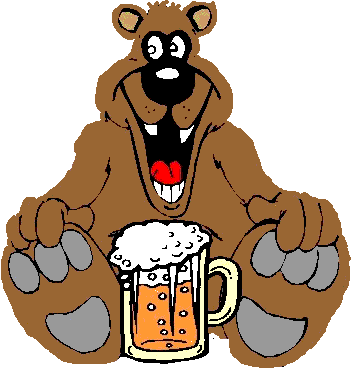 The environment was not bar-like and in my opinion it lacked the atmosphere of a true brewpub. But that said the beers were excellent. The beers that are being produced on the site are special beer and seasonal beer. And I guess that the brewery is using this tour to test beer before it hits the market. The array of beer changes almost every week, but - as far as I remember - we tried English Pale Ale, Cypress Honey Lager, Gastown Amber Ale, Island Lager and Kitsilano Maple Cream Ale.
The environment was not bar-like and in my opinion it lacked the atmosphere of a true brewpub. But that said the beers were excellent. The beers that are being produced on the site are special beer and seasonal beer. And I guess that the brewery is using this tour to test beer before it hits the market. The array of beer changes almost every week, but - as far as I remember - we tried English Pale Ale, Cypress Honey Lager, Gastown Amber Ale, Island Lager and Kitsilano Maple Cream Ale.
Before leaving the building we visited the adjacent gift shop, where you (of course) can buy beer and different sorts af beer drinking accessories. We can recommend this little tour, which last for a little less than an hour.
After we had returned to Denmark my cousin Kisten sent me these 2 wonderful pictures of False Creek taken from Granville Island.


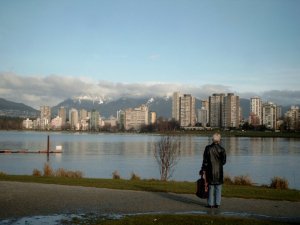 As mentioned earlier there are so many wonderful parks in Vancouver. Just 5-10 minutes walk from Granville Island you will find Vanier Park. The park (15-hectars) is located in the suburb of Kisilano next to the ocean and the sea view is absolutely astonishing. Vanier Park is home to H.R. MacMillan Space Centre with itís observatory, Planetarium and Theatre. Besides it is home to the Vancouver Museum and Vancouver Maritime Museum.
As mentioned earlier there are so many wonderful parks in Vancouver. Just 5-10 minutes walk from Granville Island you will find Vanier Park. The park (15-hectars) is located in the suburb of Kisilano next to the ocean and the sea view is absolutely astonishing. Vanier Park is home to H.R. MacMillan Space Centre with itís observatory, Planetarium and Theatre. Besides it is home to the Vancouver Museum and Vancouver Maritime Museum.In spring - usually second half of May - the Vancouver International Childrens Festival is taking placed in tents in the park. Children are entertained - and maybe educated - through programmes of jugglers, clowns and acrobats, puppet shows, dancing, storytelling, singalong concerts and music.
 After the festival - from June till September - Bard On the Beach starts in Vanier Park. This Shakespeare Festival was established in 1990 with the mission to "provide Vancouver residents and tourists with affordable, accessible Shakespearean productions of the finest quality". There are two stages: the 520-seats mainstage tent and the 240-seats studiostage. The mainstage tent is open-ended so that the actors perform against a spectacular background setting of mountains, sea and sky. This year (2005) the repertoire on the mainstage was "As you like it" and "Love's labour's lost", and on the studiostage "Hamlet, prince of Denmark" and "Rosencrantz And Guildenstern Are Dead". The theatre company employes more than thirty actors. In 2004 more than 80.000 visitors attended the performances.
After the festival - from June till September - Bard On the Beach starts in Vanier Park. This Shakespeare Festival was established in 1990 with the mission to "provide Vancouver residents and tourists with affordable, accessible Shakespearean productions of the finest quality". There are two stages: the 520-seats mainstage tent and the 240-seats studiostage. The mainstage tent is open-ended so that the actors perform against a spectacular background setting of mountains, sea and sky. This year (2005) the repertoire on the mainstage was "As you like it" and "Love's labour's lost", and on the studiostage "Hamlet, prince of Denmark" and "Rosencrantz And Guildenstern Are Dead". The theatre company employes more than thirty actors. In 2004 more than 80.000 visitors attended the performances.
 As mentioned above Vanier Park is home to the H.R. MacMillan Space Centre, made up of a planetarium and an observatory. The planetarium is considered one of the best in North America. Any way withs its beautiful views over Vancouver and the ocean it is no doubt the best situated space centre anywhere. The centre, which was built in 1968, but has undergone many transformations since then, is attached to the Vancouver Museum. It is quite a unique building with its round shape and the huge metal crab in front of it. Aside from the planetarium and observatory, it also features the Cosmic Courtyard hands-on gallery, a Virtual Voyages full-motion simulator, GroundStation Canada exhibits and multimedia and laser shows. An advanced projector creates a 360-degree view of the universe as seen from Vancouver. The planetarium's multi-media dome is 20 meters in diameter. Its overnight adventures and space camps are popular.
As mentioned above Vanier Park is home to the H.R. MacMillan Space Centre, made up of a planetarium and an observatory. The planetarium is considered one of the best in North America. Any way withs its beautiful views over Vancouver and the ocean it is no doubt the best situated space centre anywhere. The centre, which was built in 1968, but has undergone many transformations since then, is attached to the Vancouver Museum. It is quite a unique building with its round shape and the huge metal crab in front of it. Aside from the planetarium and observatory, it also features the Cosmic Courtyard hands-on gallery, a Virtual Voyages full-motion simulator, GroundStation Canada exhibits and multimedia and laser shows. An advanced projector creates a 360-degree view of the universe as seen from Vancouver. The planetarium's multi-media dome is 20 meters in diameter. Its overnight adventures and space camps are popular. The space centre has all sorts of programs, both educational and entertaining. Fx there is a programme available where highschool students give lectures on space to elementary school children in the community. Or you migh join a Rocket Building Workshop. Britt's - our granddaughter - daycare paid a visit to the space centre a couple of times every year. So of couse we had to come to se the kids have fun and travel through cosmos. We can definitely recommend to spend an afternoon at the space centre - or maybe a whole day.
The space centre has all sorts of programs, both educational and entertaining. Fx there is a programme available where highschool students give lectures on space to elementary school children in the community. Or you migh join a Rocket Building Workshop. Britt's - our granddaughter - daycare paid a visit to the space centre a couple of times every year. So of couse we had to come to se the kids have fun and travel through cosmos. We can definitely recommend to spend an afternoon at the space centre - or maybe a whole day.Harvey Reginald MacMillan (1885-1976) was a lumber magnate. He came from Ontario to Vancouver in 1908 as assistant inspector in Western Canada Forest Reserves, but had to spend two years in a TB sanitorium. In 1912 he was appointed chief B.C. forester. In 1919 he started H.R. MacMillan Export. BTW his manager and later partner was W.J. VanDusen - see below.
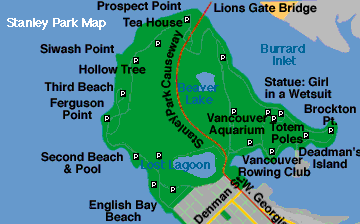 The 400 hectar Stanley Park - the largest in Canada - is situated close to downtown is one of the greatest treasures of the city and a tribute to the foresight of Vancouverís founding fathers. In the 1860s the area was a military reserve intended to protect the seaport from possible attack. (Americans had made the colony nervous with a military occupation of the San Juan Islands in the Gulf of Georgia only four years earlier). However it was never needed for that purpose, and in 1886 it was incorporated in the city as a park. To be honest it was not a gift, but the Federal Government leased the area to the City of Vancouver for $1.00 per year for then next 100 years (I don't know what happened in 1986, but I guess that it now belongs to the city). A seawall path "hugs" the Pacific shoreline for 10 kilometres, making the area a popular destination for walkers, cyclists and rollerbladers. Youíll also find beaches, swimming spots, harbour views, mandarin ducks, trumpeter swans, Canadian geese, beautiful gardens, an old rainforest, an astonishing aquarium, summer theater (Theater under the Stars), a miniature railway,checkerboard, and a farmyard for children and numerous sport facilities.
The 400 hectar Stanley Park - the largest in Canada - is situated close to downtown is one of the greatest treasures of the city and a tribute to the foresight of Vancouverís founding fathers. In the 1860s the area was a military reserve intended to protect the seaport from possible attack. (Americans had made the colony nervous with a military occupation of the San Juan Islands in the Gulf of Georgia only four years earlier). However it was never needed for that purpose, and in 1886 it was incorporated in the city as a park. To be honest it was not a gift, but the Federal Government leased the area to the City of Vancouver for $1.00 per year for then next 100 years (I don't know what happened in 1986, but I guess that it now belongs to the city). A seawall path "hugs" the Pacific shoreline for 10 kilometres, making the area a popular destination for walkers, cyclists and rollerbladers. Youíll also find beaches, swimming spots, harbour views, mandarin ducks, trumpeter swans, Canadian geese, beautiful gardens, an old rainforest, an astonishing aquarium, summer theater (Theater under the Stars), a miniature railway,checkerboard, and a farmyard for children and numerous sport facilities.In 1909 the City of New York presented Vancouver with a gift of eight pairs of grey squirrels for Stanley Park. Now the park is crowded with these beautiful creatures, who are favourites of city residents and visitors a like. Stand/sit still with some seeds or nuts in your hand and inevitable within a few minutes one or two squirrels will approach and make a grab for them. All park swans are descendants of a single pair obtained from New South Wales Zoological Society in 1901.
We took SkyTrain to Granville Station and walked maybe 15 minutes along Georgia Street to Stanley Park, where we just strolled around. Since our latest visit rollerskaters had become pretty dominating in the park. And we guess that Vancouver is the first city to impose speed control for rollerskaters, and the police might fine you for speeding excess 15 km/hour. Last time we were in Stanley Park we took a guided your in a horse-drawn carriage around the park. But this time we preferred to walk around for a couple of hours.

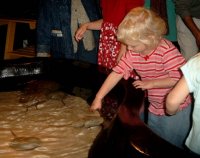 This time we did not visit Vancouver Aquarium, but it certainly is worth while visiting - probably one of the most impressing aquariums in the world. More than 8.000 different sea animals from the Pacific can be seen here. It presents several shows every day (and I mean every day, since it is open to the public 365 days a year). Janet and Claus have a "family card", so the often bring Britt to the aquarium for fun and entertainment. When we were there the daily program looked like this:
This time we did not visit Vancouver Aquarium, but it certainly is worth while visiting - probably one of the most impressing aquariums in the world. More than 8.000 different sea animals from the Pacific can be seen here. It presents several shows every day (and I mean every day, since it is open to the public 365 days a year). Janet and Claus have a "family card", so the often bring Britt to the aquarium for fun and entertainment. When we were there the daily program looked like this:
11:00 Beluga Show
11:30 Sea Otter Feed
12:00 Shark Dive Show
12:30 Beluga Show
14:00 Sea Otter Feed
14:30 Beluga Show
15:30 Pacific Canada Dive Show
16:30 Beluga Show
17:00 Sea Otter Feed
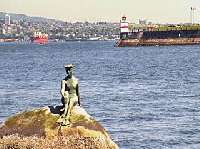 On our walk we also met a copy of "The little Mermaid" (remember the fairy tale by Hans Christian Andersen?. In fact not a copy but a look-alike. 30 years ago Stanley Park asked the city of Copenhagen for permission to make a replica of the statue, which is to be seen in Copenhagen Harbour. But for some strange reason (at least unknown to me) they were not allowed to do so. So they equipped the statue with a swim suit and called it "Girl in a Wetsuit". On the picture you see the lighthouse at Brockton Point in the background.
On our walk we also met a copy of "The little Mermaid" (remember the fairy tale by Hans Christian Andersen?. In fact not a copy but a look-alike. 30 years ago Stanley Park asked the city of Copenhagen for permission to make a replica of the statue, which is to be seen in Copenhagen Harbour. But for some strange reason (at least unknown to me) they were not allowed to do so. So they equipped the statue with a swim suit and called it "Girl in a Wetsuit". On the picture you see the lighthouse at Brockton Point in the background.
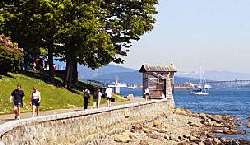 Every night at 9 o'clock a gun is fired from a position close to Brockton Point. Under optimal atmospheric conditions it can be heard some 70 kilometers away. This 12 pound muzzle-loader was cast at Woolwich in England in 1816. In 1894 it was installed at Hallelujah Point, close to it's present position. In earlier days - that is before 1894 - it was the lighthouse keeper at Brockton Point's job to detonate a charge of dynamite at 9.00 PM every night as an "aid to navigation". At that time sailing ships relied on tides and needed accurate time readings and they set their chronometers according to the signal. In fact not from the noise of the charge but from the flash.
Every night at 9 o'clock a gun is fired from a position close to Brockton Point. Under optimal atmospheric conditions it can be heard some 70 kilometers away. This 12 pound muzzle-loader was cast at Woolwich in England in 1816. In 1894 it was installed at Hallelujah Point, close to it's present position. In earlier days - that is before 1894 - it was the lighthouse keeper at Brockton Point's job to detonate a charge of dynamite at 9.00 PM every night as an "aid to navigation". At that time sailing ships relied on tides and needed accurate time readings and they set their chronometers according to the signal. In fact not from the noise of the charge but from the flash.
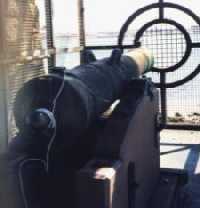 The cannon was originally placed in Nanaimo on Vancouver Island and in the mid-19th century it was in action during the US-Canada boundary dispute. The Time Gun has only been silenced during World War II and in 1969, when it was 'kidnapped' by UBC engineering students and held for ransom. The studens returned the gun in exchange for a "ransom" donated to the Childrenís Hospital. Another story tells that a son loaded his father's ashes into the barrel just before 9pm. Nowadays the gun is safely welded to its base and protected by a secure metal cage, so don't get any fancy ideas. Today the gun is fired electrically.
The cannon was originally placed in Nanaimo on Vancouver Island and in the mid-19th century it was in action during the US-Canada boundary dispute. The Time Gun has only been silenced during World War II and in 1969, when it was 'kidnapped' by UBC engineering students and held for ransom. The studens returned the gun in exchange for a "ransom" donated to the Childrenís Hospital. Another story tells that a son loaded his father's ashes into the barrel just before 9pm. Nowadays the gun is safely welded to its base and protected by a secure metal cage, so don't get any fancy ideas. Today the gun is fired electrically.
At "The Third Beach" there is a huge red cedar, almost 30 metres around. National Geographic Society has "adopted" the tree, which they consider the largest of its kind in the world. Close to it is another fascinating tree, The Hollow Tree.
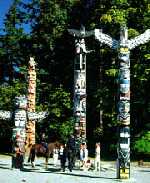 On our way back we passed the impressing totem poles, carved by members of the Haida Nation - maybe not quite as impressing as the poles, that we had seen on the UBC Museum.
On our way back we passed the impressing totem poles, carved by members of the Haida Nation - maybe not quite as impressing as the poles, that we had seen on the UBC Museum.
One of the most beautiful places in the park is the Lost Lagoon. The name comes from a poem, Legends of Vancouver, The Lost Lagoon by Pauline Johnson(1861-1913). Pauline Johnson was of mixed heritage her father beeing a mohawk chief and her mother British. You may want to study some of the beautiful Indian Legends, that she collected. In accordance with her last wish, her ashes were buried in Stanley Park within sight and sound of Siwash Rock. Until 1929 Lost Lagoon was a freshwater lake. Today itís a wild-bird sanctuary and the path around it makes for a wonderful walk.
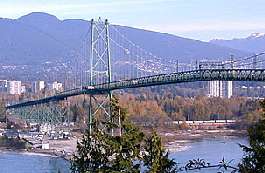 From Prospect Point there is a wonderful view at the mountains and Lions Gate Bridge. This famous bridge was built in 1937 by the Guiness family - yes, the beer family - as they decided to invest in land on the North Shore. In 1932 they purchased 4,000 acres of West Vancouver mountain side. The plan was develop the land and make people move there. The project as you can imagine was popular during the depression, and objections to the fact that an access road through the heart of Stanley Park had to be constructed were overcome. When built this 472 meter long and 111 meter high bridge was the longest suspension bridge in the world. More than 60.000 cars pass the bridge every day. As traffic increased the Lions Gate Bridge often congested during rush hours, and in 1998 it was decided to renovate and widen the bridge. Hope was that this would add another 30 years of life to the bridge. Work was done night and on weekends, when the Second Narrows Bridge could take up the volume.
From Prospect Point there is a wonderful view at the mountains and Lions Gate Bridge. This famous bridge was built in 1937 by the Guiness family - yes, the beer family - as they decided to invest in land on the North Shore. In 1932 they purchased 4,000 acres of West Vancouver mountain side. The plan was develop the land and make people move there. The project as you can imagine was popular during the depression, and objections to the fact that an access road through the heart of Stanley Park had to be constructed were overcome. When built this 472 meter long and 111 meter high bridge was the longest suspension bridge in the world. More than 60.000 cars pass the bridge every day. As traffic increased the Lions Gate Bridge often congested during rush hours, and in 1998 it was decided to renovate and widen the bridge. Hope was that this would add another 30 years of life to the bridge. Work was done night and on weekends, when the Second Narrows Bridge could take up the volume.
Whitford Julian VanDusen (1889-1978) was a lumber magnate. In 1919 he joined H.R. MacMillan Export as manager anf senior vice president from 1945-1949 and vice chair from 1949-1956. He did not retire until 1969. VanDusen was involved in philanthropic works as Vancouver Foundation (1943). He donated the purchase amount for the Shaughnessy Golf Course, now the VanDusen Botanical Gardens.
The 52 hectar Queen Elizabeth Park has around 6 million visitors a year. The park was originally a quarry supplying rocks to build Vancouver's first roadways. In 1929 the city proceeded to acquire the property which had become an abandoned eyesore. It was dedicated as a park by King George VI and his wife, Queen Elizabeth (the present Queen's mother) on a visit to Vancouver in 1939.